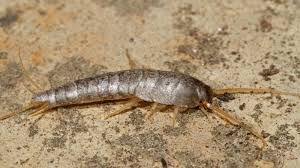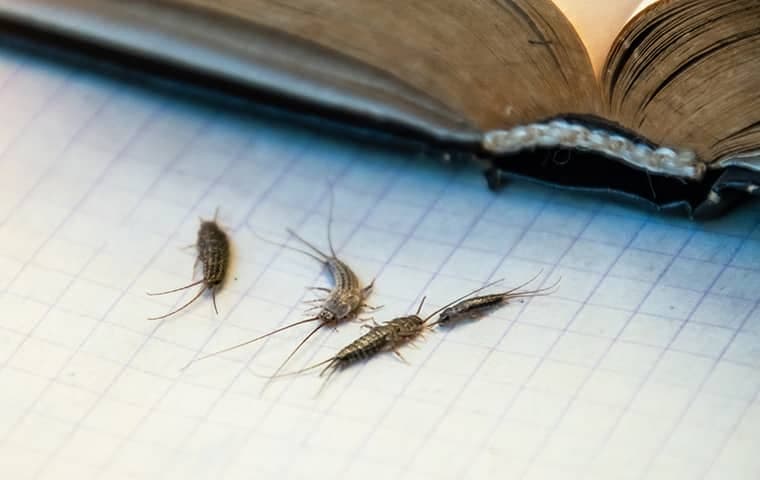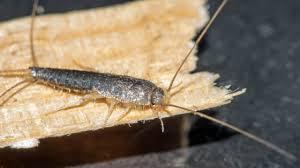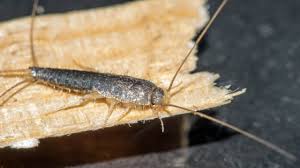Silverfish scientifically known as Lepisma saccharina is a tiny insect that you might find scurrying around in dark and damp places. These small creatures are not harmful to humans, but they can be quite interesting to learn about.
Silverfish are usually silvery or grayish in color, and they get their name from their appearance, which resembles a fish. Despite their fish-like shape, silverfish are not aquatic; instead, they prefer dark and humid environments. You might discover them in places like basements, bathrooms, or kitchens.
One unique feature of silverfish is their ability to move quickly. These insects have a distinctive wiggling motion as they travel, making them quite agile. Although they may seem harmless, silverfish can be a nuisance as they enjoy feasting on various items found in households.
Silverfish are known for their diet, which includes carbohydrates such as sugars and starches. They have a particular liking for paper and book bindings, making them a potential threat to documents and books. Additionally, they may indulge in consuming glue, fabrics, and even some food items left unprotected.
These insects undergo a process called gradual metamorphosis, meaning they go through three stages: egg, nymph, and adult. The eggs are tiny and typically hidden in crevices or secluded spots. After hatching, the young silverfish, known as nymphs, resemble miniature versions of the adults.
Silverfish have been around for a long time, with a history dating back millions of years. Fossil evidence suggests that their basic body structure has remained relatively unchanged over time, highlighting their adaptability and successful survival strategies.
To prevent silverfish infestations, it’s crucial to maintain a dry and well-ventilated environment. Fixing leaks, reducing humidity, and sealing potential entry points can help keep these insects at bay. While silverfish are not considered harmful to humans, they can be a nuisance when they invade living spaces.
However, silverfish are intriguing creatures with a distinctive appearance and behavior. Despite their small size, they play a role in nature’s balance. Understanding their habits and preferences can aid in managing and preventing potential issues with these curious insects in our homes.
Read Also: Importance and Types of Pets
Things Affected by Silverfish (Lepisma saccharina)

Silverfish are known for their dietary habits, and while they primarily feed on carbohydrates like sugars and starches, their preferences can lead to interactions with various items. Although silverfish are not directly harmful to humans, they can indirectly affect certain materials and other living organisms in their environment.
1. Paper Products: Silverfish have a penchant for paper and items made of cellulose, such as books, magazines, and cardboard. This can be problematic in homes or libraries where these insects may damage important documents or cherished reading materials.
2. Textiles: Fabrics, including cotton and linen, can attract silverfish. They may nibble on clothing items stored in dark and humid spaces. This can result in small holes and damage to garments.
3. Glue and Paste: Silverfish are attracted to adhesives used in book bindings, wallpaper, and other household items. Their consumption of glue can lead to structural damage in certain materials.
4. Stored Food: While not their primary food source, silverfish may be found in kitchens where they can nibble on food items such as cereals and flour. Though their impact on stored food is minimal, it can still be a concern in some cases.
5. Fungi and Mold: Silverfish are often found in damp environments, and they may indirectly contribute to the growth of fungi and mold. The presence of these insects could signal excessive humidity, which is conducive to mold formation.
6. Other Insects: Silverfish are not known to be aggressive towards other insects, but they may compete for the same resources. In environments with limited food sources, silverfish might have indirect interactions with other small insects.
It’s important to note that while silverfish may affect certain materials, they are not considered a direct threat to the health or well-being of humans or pets. Managing humidity levels, fixing leaks, and storing items properly can help reduce the likelihood of silverfish infestations and minimize their impact on the surrounding environment.
Damages Caused by Silverfish

Silverfish, though generally harmless to humans and pets, can cause damage to various items within their preferred habitats. Their diet, consisting mainly of carbohydrates, leads them to target specific materials, potentially resulting in the following damages:
1. Paper and Documents: Silverfish have a particular fondness for paper, including documents, books, and cardboard. Over time, their feeding habits can result in holes, notches, and damage to paper-based items. This can be a concern, especially for important documents or cherished books.
2. Fabrics and Clothing: Clothing items made of natural fibers, such as cotton and linen, may attract silverfish. The insects can nibble on fabrics stored in dark and humid areas, causing small holes and damage to garments.
3. Wallpaper and Adhesives: The glue used in wallpaper, book bindings, and other adhesives is a target for silverfish. Their consumption of these materials can lead to structural damage, affecting the integrity of wallpaper or the binding of books.
4. Stored Food Items: While not their primary food source, silverfish may venture into kitchens and pantries. They can nibble on stored food items like cereals and flour. While the damage to food is typically minimal, it can still be a concern for some households.
5. Damage to Artwork: Artwork and photographs, especially those stored in humid conditions, may be susceptible to silverfish damage. The insects can leave behind small holes or chewed edges on paper-based artwork.
6. Starched Items: Items containing starch, such as glues in book bindings or certain types of wallpaper, are attractive to silverfish. Their consumption of starched materials can lead to weakening and damage.
It’s important to address silverfish infestations promptly to minimize potential damages. Implementing preventive measures, such as reducing humidity, fixing leaks, and storing items properly, can help mitigate the impact of silverfish on personal belongings and household items. While the damages caused by silverfish are often more of a nuisance than a serious threat, proactive management can help maintain the integrity of various materials in the home.
Read Also: Lynx Point Siamese Cat Breed Description and Care Guide
Control and Preventive Measures

Controlling and preventing silverfish infestations involves a combination of proactive measures to create an environment that is less conducive to their habits. Here are some effective control and preventive measures:
1. Reduce Humidity: Silverfish thrive in humid conditions. Use dehumidifiers to maintain lower humidity levels, especially in basements, bathrooms, and other damp areas. Adequate ventilation can also help prevent excessive moisture buildup.
2. Fix Leaks: Silverfish are often attracted to areas with water leaks. Regularly inspect and promptly repair any leaks in plumbing, roofs, or windows to eliminate potential hiding spots for silverfish.
3. Seal Entry Points: Seal cracks, gaps, and entry points around doors, windows, and foundation areas. Preventing their entry into the home reduces the likelihood of a silverfish infestation.
4. Store Items Properly: Store paper-based items, books, and clothing in airtight containers. This makes it more difficult for silverfish to access and damage these materials. Consider using plastic containers instead of cardboard boxes.
5. Regular Cleaning: Regularly vacuum and dust areas where silverfish are likely to hide. This helps remove potential food sources and reduces the appeal of the environment for these insects.
6. Natural Repellents: Use natural repellents such as cedarwood or essential oils like lavender, citrus, or cinnamon. These scents are known to be unappealing to silverfish and can act as deterrents.
7. Insecticides: Apply residual insecticides in cracks, crevices, and areas where silverfish are commonly found. Choose insecticides labeled for silverfish control, and follow the instructions carefully to ensure safety.
8. Boric Acid: Boric acid is an effective and low-toxicity option for controlling silverfish. Apply it in areas where silverfish are likely to travel, but be cautious to keep it away from children and pets.
9. Professional Pest Control: If silverfish infestations persist or are severe, consider hiring a professional pest control service. They can assess the situation and provide targeted treatments to eliminate the infestation.
By incorporating these measures into your home maintenance routine, you can create an environment that is less attractive to silverfish, reducing the risk of infestations and minimizing potential damages to your belongings. Regular vigilance and proactive steps are key to effective silverfish control.
Frequently Asked Questions (FAQs) About Silverfish (Lepisma saccharina)
1. Q: What do silverfish look like?
A: Silverfish are small, wingless insects with a silvery or grayish color. They have a distinctive fish-like shape and move with a unique wiggling motion.
2. Q: Are silverfish harmful to humans?
A: Silverfish are generally not harmful to humans or pets. They do not bite, sting, or transmit diseases. However, they can be a nuisance due to their feeding habits.
3. Q: What do silverfish eat?
A: Silverfish primarily feed on carbohydrates such as sugars and starches. They have a particular liking for paper, book bindings, fabrics, glues, and certain food items.
4. Q: Where do silverfish commonly hide?
A: Silverfish prefer dark and damp environments. Common hiding spots include basements, bathrooms, kitchens, and other areas with high humidity levels.
5. Q: How do I prevent silverfish infestations?
A: Prevent silverfish infestations by reducing humidity, fixing leaks, sealing entry points, storing items in airtight containers, and regularly cleaning areas where silverfish may hide.
6. Q: Can silverfish damage my belongings?
A: Yes, silverfish can damage paper-based items, fabrics, glues, and certain stored foods. They may leave small holes or chewed edges on these materials.
7. Q: Are there natural repellents for silverfish?
A: Yes, natural repellents such as cedarwood, lavender, citrus, and cinnamon can act as deterrents for silverfish. Placing these scents in affected areas may help discourage them.
8. Q: How do I get rid of silverfish in my home?
A: Control silverfish by using preventive measures like reducing humidity, sealing entry points, and storing items properly. Natural repellents, insecticides, boric acid, and professional pest control are additional options.
9. Q: Can silverfish infestations be serious?
A: While silverfish are not harmful to health, severe infestations can lead to damage of personal belongings. Managing humidity and implementing preventive measures can help avoid serious issues.
10. Q: What is the life cycle of a silverfish?
A: Silverfish undergo gradual metamorphosis with three stages: egg, nymph, and adult. The eggs are small and hidden, and the nymphs resemble miniature adults after hatching.

